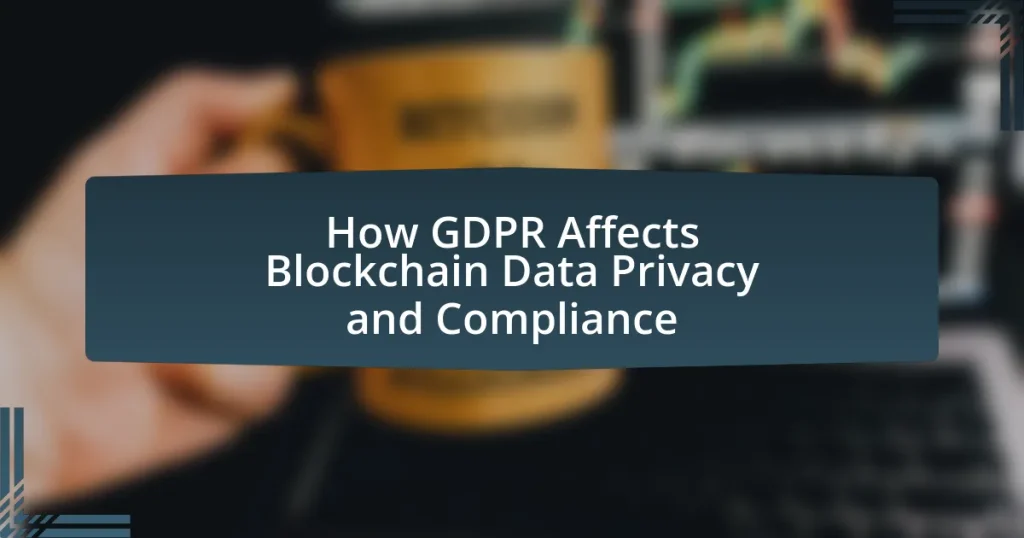The article examines the impact of the General Data Protection Regulation (GDPR) on blockchain data privacy and compliance. It highlights the challenges posed by GDPR’s principles, such as the right to erasure and data minimization, which conflict with blockchain’s immutable and decentralized nature. Key topics include the definition of personal data in the context of blockchain, implications of data subject rights, and the necessity for organizations to implement technical solutions like off-chain storage and encryption to align with GDPR requirements. Additionally, the article discusses the risks of non-compliance, the role of smart contracts, and best practices for organizations navigating GDPR and blockchain integration.

How does GDPR impact blockchain data privacy?
GDPR significantly impacts blockchain data privacy by imposing strict regulations on the processing of personal data, which affects how blockchain technology can be utilized. The regulation mandates that personal data must be processed lawfully, transparently, and for specific purposes, which can conflict with the immutable and decentralized nature of blockchain. For instance, GDPR grants individuals the right to erasure, also known as the “right to be forgotten,” which poses challenges for blockchain systems where data cannot be easily altered or deleted. This tension between GDPR requirements and blockchain’s inherent characteristics necessitates careful consideration and potential adaptations in blockchain implementations to ensure compliance with data privacy laws.
What are the key principles of GDPR that affect blockchain?
The key principles of GDPR that affect blockchain include data minimization, purpose limitation, and the right to erasure. Data minimization mandates that only necessary personal data should be processed, which conflicts with blockchain’s immutable nature where all data is permanently recorded. Purpose limitation requires that personal data be collected for specific, legitimate purposes, which can be challenging in decentralized systems where data may be used for multiple unforeseen purposes. The right to erasure, also known as the “right to be forgotten,” poses a significant challenge for blockchain, as it contradicts the fundamental characteristic of blockchain technology, which is to maintain an unalterable record of transactions. These principles create tension between GDPR compliance and the inherent features of blockchain technology, necessitating careful consideration for organizations utilizing blockchain in relation to personal data.
How does GDPR define personal data in the context of blockchain?
GDPR defines personal data as any information relating to an identified or identifiable natural person, which includes names, identification numbers, location data, and online identifiers. In the context of blockchain, this definition raises challenges because blockchain’s inherent characteristics, such as immutability and transparency, can conflict with the GDPR’s requirements for data erasure and the right to be forgotten. The European Data Protection Board has indicated that if personal data is stored on a blockchain, it must still comply with GDPR principles, meaning that data controllers must ensure that personal data can be managed in a way that respects individuals’ rights under the regulation.
What are the implications of data subject rights under GDPR for blockchain?
Data subject rights under GDPR significantly challenge the immutable nature of blockchain technology. GDPR grants individuals rights such as the right to access, the right to rectification, and the right to erasure, which conflict with blockchain’s permanent record-keeping. For instance, the right to erasure, also known as the “right to be forgotten,” poses a direct contradiction to the core principle of blockchain, where data cannot be altered or deleted once recorded. This creates legal complexities for organizations using blockchain, as they must find ways to comply with GDPR while maintaining the integrity of the blockchain. Additionally, the decentralized nature of blockchain complicates the identification of data controllers and processors, which are essential for GDPR compliance. These implications necessitate innovative solutions, such as the use of off-chain storage or privacy-enhancing technologies, to reconcile GDPR requirements with blockchain’s characteristics.
Why is compliance with GDPR crucial for blockchain technology?
Compliance with GDPR is crucial for blockchain technology because it ensures the protection of personal data and upholds individuals’ privacy rights. The General Data Protection Regulation mandates that organizations handling personal data must implement strict data protection measures, which can conflict with blockchain’s inherent characteristics of immutability and transparency. For instance, GDPR requires the ability to delete personal data upon request, a challenge for blockchain systems where data is permanently recorded. Failure to comply can result in significant fines, reaching up to 4% of annual global turnover or €20 million, whichever is higher, as outlined in Article 83 of the GDPR. Therefore, aligning blockchain operations with GDPR not only mitigates legal risks but also fosters trust among users regarding data privacy.
What risks do blockchain companies face if they fail to comply with GDPR?
Blockchain companies face significant risks if they fail to comply with GDPR, including substantial financial penalties, legal actions, and reputational damage. Non-compliance can result in fines of up to 4% of annual global turnover or €20 million, whichever is higher, as stipulated by GDPR regulations. Additionally, these companies may face lawsuits from individuals whose data rights have been violated, leading to further financial liabilities. The reputational damage can deter customers and partners, impacting business operations and growth. Furthermore, regulatory scrutiny may increase, leading to more stringent oversight and operational challenges.
How can non-compliance affect user trust in blockchain applications?
Non-compliance with regulations such as GDPR can significantly undermine user trust in blockchain applications. When blockchain applications fail to adhere to data protection laws, users may perceive these platforms as insecure or untrustworthy, leading to a reluctance to engage with them. For instance, a survey by the European Union Agency for Cybersecurity found that 70% of users are concerned about their data privacy when using digital services, indicating that compliance is crucial for fostering user confidence. Furthermore, instances of non-compliance can result in legal penalties and reputational damage, further eroding trust among current and potential users.

What challenges does blockchain face in achieving GDPR compliance?
Blockchain faces significant challenges in achieving GDPR compliance primarily due to its inherent characteristics of immutability and decentralization. The immutability of blockchain means that once data is recorded, it cannot be altered or deleted, which conflicts with GDPR’s requirements for data subjects to have the right to erasure, also known as the “right to be forgotten.” Additionally, the decentralized nature of blockchain complicates the identification of a data controller, as GDPR mandates that a data controller must be identifiable and accountable for data processing activities. This lack of a central authority makes it difficult to ensure compliance with GDPR’s accountability and transparency requirements. Furthermore, the pseudonymization of data on blockchain does not fully satisfy GDPR’s standards for personal data protection, as it may still allow for re-identification under certain circumstances.
How does the immutability of blockchain conflict with GDPR requirements?
The immutability of blockchain conflicts with GDPR requirements primarily because GDPR mandates the right to erasure, also known as the “right to be forgotten.” This right allows individuals to request the deletion of their personal data, which contradicts the fundamental characteristic of blockchain that ensures data, once recorded, cannot be altered or deleted. For instance, Article 17 of the GDPR explicitly states that individuals have the right to request the deletion of their personal data when it is no longer necessary for the purposes for which it was collected. This creates a legal tension, as blockchain’s design inherently prevents compliance with such requests, leading to challenges in aligning decentralized systems with regulatory frameworks that prioritize individual data control and privacy.
What are the implications of data erasure requests on blockchain records?
Data erasure requests, as mandated by GDPR, pose significant challenges for blockchain records due to the immutable nature of blockchain technology. When a data subject requests erasure, it conflicts with the fundamental principle that once data is recorded on a blockchain, it cannot be altered or deleted without consensus from the network participants. This creates a dilemma for organizations that must comply with GDPR while also maintaining the integrity of blockchain records.
For instance, the European Data Protection Board has acknowledged that the right to erasure may not be fully compatible with blockchain’s design, which is intended to ensure transparency and trust through permanent records. Consequently, organizations may need to implement technical solutions, such as off-chain storage or encryption, to comply with GDPR while still preserving the essential characteristics of blockchain.
How can blockchain developers address the right to be forgotten?
Blockchain developers can address the right to be forgotten by implementing off-chain storage solutions and cryptographic techniques that allow for data deletion or modification without compromising the integrity of the blockchain. By storing personal data off-chain and linking it to the blockchain through hashes, developers can facilitate the removal of data while maintaining a record of transactions. This approach aligns with GDPR requirements, as it enables individuals to request the deletion of their personal information while still preserving the immutable nature of the blockchain for other data.
What technical solutions exist to enhance GDPR compliance in blockchain?
Technical solutions to enhance GDPR compliance in blockchain include data encryption, off-chain storage, and the implementation of privacy-focused protocols. Data encryption ensures that personal data is protected and only accessible to authorized parties, aligning with GDPR’s data protection requirements. Off-chain storage allows sensitive information to be stored outside the blockchain, reducing the risk of exposing personal data on a public ledger. Privacy-focused protocols, such as zero-knowledge proofs, enable transactions to be verified without revealing the underlying personal data, thus maintaining user privacy while complying with GDPR regulations. These solutions collectively address the challenges posed by the immutable nature of blockchain in relation to GDPR’s right to erasure and data minimization principles.
How can encryption and pseudonymization help meet GDPR standards?
Encryption and pseudonymization are essential techniques that help organizations meet GDPR standards by enhancing data protection and privacy. Encryption secures personal data by converting it into an unreadable format, ensuring that unauthorized parties cannot access sensitive information. This aligns with GDPR’s requirement for data security, as outlined in Article 32, which mandates appropriate technical measures to protect personal data.
Pseudonymization, on the other hand, reduces the likelihood of identifying individuals from their data by replacing identifiable information with pseudonyms. This practice supports GDPR principles by minimizing the risk associated with data processing, as stated in Recital 26, which emphasizes that data that cannot be attributed to a specific individual without additional information is not considered personal data.
Together, these methods not only protect personal data but also facilitate compliance with GDPR’s accountability principle, as organizations can demonstrate that they have implemented effective measures to safeguard data.
What role do smart contracts play in ensuring compliance?
Smart contracts play a crucial role in ensuring compliance with regulations like GDPR by automating and enforcing the terms of agreements without the need for intermediaries. They facilitate compliance by embedding regulatory requirements directly into the code, ensuring that data handling practices adhere to legal standards. For instance, smart contracts can automatically execute data access requests or deletion protocols, thereby ensuring that organizations meet GDPR mandates for data subject rights. This automation reduces the risk of human error and enhances transparency, as all transactions are recorded on the blockchain, providing an immutable audit trail that can be reviewed for compliance verification.

How can organizations effectively navigate GDPR and blockchain integration?
Organizations can effectively navigate GDPR and blockchain integration by implementing data protection measures that align with GDPR requirements while leveraging blockchain’s decentralized nature. This involves conducting thorough data assessments to identify personal data processed on the blockchain, ensuring that data subjects’ rights, such as access and erasure, are respected, and utilizing privacy-enhancing technologies like zero-knowledge proofs to minimize personal data exposure. Additionally, organizations should establish clear data governance policies and maintain transparency with users regarding data processing activities, as mandated by GDPR. These strategies help ensure compliance while maximizing the benefits of blockchain technology.
What best practices should organizations follow for GDPR compliance in blockchain?
Organizations should implement data minimization, ensure transparency, and establish data subject rights to achieve GDPR compliance in blockchain. Data minimization involves collecting only the necessary personal data for specific purposes, which aligns with GDPR’s principle of limiting data collection. Transparency requires organizations to clearly inform users about how their data will be used, stored, and processed on the blockchain, ensuring that privacy notices are accessible and understandable. Establishing data subject rights means enabling individuals to exercise their rights, such as access, rectification, and erasure of their personal data, even in a decentralized environment. These practices are essential as they directly address GDPR requirements and help organizations mitigate risks associated with non-compliance, which can lead to significant fines and reputational damage.
How can organizations conduct a data protection impact assessment for blockchain projects?
Organizations can conduct a data protection impact assessment (DPIA) for blockchain projects by following a structured process that includes identifying the need for a DPIA, describing the information flows, assessing risks, and consulting with stakeholders. The General Data Protection Regulation (GDPR) mandates that organizations assess the impact of their data processing activities on the privacy of individuals, particularly when using technologies like blockchain that may pose unique risks.
To begin, organizations should determine whether a DPIA is necessary based on the likelihood and severity of risks to data subjects’ rights and freedoms. Next, they must document the nature of the data being processed, the purpose of processing, and the parties involved in the data flow. This step is crucial for understanding how personal data is handled within the blockchain environment.
Following this, organizations should evaluate potential risks associated with the processing activities, including data breaches, unauthorized access, and the immutability of blockchain records, which can complicate data deletion requests under GDPR. Engaging with stakeholders, such as data protection officers and legal advisors, is essential to ensure that all perspectives are considered and that compliance requirements are met.
Finally, organizations should implement measures to mitigate identified risks and document the DPIA process, including the outcomes and any decisions made. This documentation serves as evidence of compliance with GDPR requirements and can be reviewed by regulatory authorities if necessary.
What training and awareness programs are essential for compliance teams?
Essential training and awareness programs for compliance teams include GDPR-specific training, data protection impact assessments, and ongoing compliance updates. GDPR-specific training equips compliance teams with the necessary knowledge about data protection regulations, emphasizing the importance of lawful data processing and individual rights. Data protection impact assessments train teams to identify and mitigate risks associated with data processing activities, ensuring compliance with GDPR requirements. Ongoing compliance updates keep teams informed about regulatory changes and best practices, fostering a culture of continuous improvement in data privacy and compliance efforts. These programs are critical for ensuring that compliance teams effectively navigate the complexities of GDPR in the context of blockchain data privacy.
What resources are available for organizations seeking guidance on GDPR and blockchain?
Organizations seeking guidance on GDPR and blockchain can access several resources, including official guidelines from the European Data Protection Board (EDPB), which provides comprehensive documentation on GDPR compliance. Additionally, the International Association for Privacy Professionals (IAPP) offers training and resources specifically addressing the intersection of GDPR and blockchain technology. Legal firms specializing in data protection law, such as DLA Piper and Baker McKenzie, publish white papers and articles that analyze GDPR implications for blockchain. Furthermore, industry-specific organizations, like the Blockchain Research Institute, provide insights and case studies on best practices for compliance. These resources collectively support organizations in navigating the complexities of GDPR in relation to blockchain technology.
How can legal experts assist in navigating GDPR challenges in blockchain?
Legal experts can assist in navigating GDPR challenges in blockchain by providing specialized knowledge on data protection laws and their implications for blockchain technology. They can analyze how blockchain’s immutable nature conflicts with GDPR’s requirements for data erasure and consent, guiding organizations on compliance strategies. Legal experts can also help in drafting privacy policies that align with GDPR, ensuring that data subjects’ rights are respected while utilizing blockchain solutions. Their expertise is crucial in interpreting legal texts and applying them to the unique characteristics of blockchain, thus facilitating informed decision-making and risk management in compliance efforts.
What industry collaborations can help improve compliance efforts?
Industry collaborations that can help improve compliance efforts include partnerships between technology providers, regulatory bodies, and industry associations. These collaborations facilitate the sharing of best practices, resources, and tools necessary for adhering to compliance standards such as GDPR. For instance, the collaboration between the International Association of Privacy Professionals (IAPP) and various tech companies has led to the development of training programs and resources that enhance understanding of compliance requirements. Additionally, joint initiatives like the Blockchain Privacy Working Group, which includes members from various sectors, aim to create frameworks that align blockchain technology with GDPR mandates, thereby improving compliance efforts across the industry.
What are the key takeaways for ensuring GDPR compliance in blockchain applications?
To ensure GDPR compliance in blockchain applications, organizations must implement data minimization, ensure the right to erasure, and establish clear data governance. Data minimization requires that only necessary personal data is collected and processed, aligning with GDPR’s principle of limiting data to what is essential for the intended purpose. The right to erasure, also known as the “right to be forgotten,” necessitates mechanisms to delete personal data from the blockchain, which is inherently challenging due to its immutable nature. Establishing clear data governance involves defining roles and responsibilities for data protection, ensuring transparency in data processing activities, and conducting regular impact assessments to identify and mitigate risks associated with personal data handling. These practices collectively support compliance with GDPR while leveraging blockchain technology.










